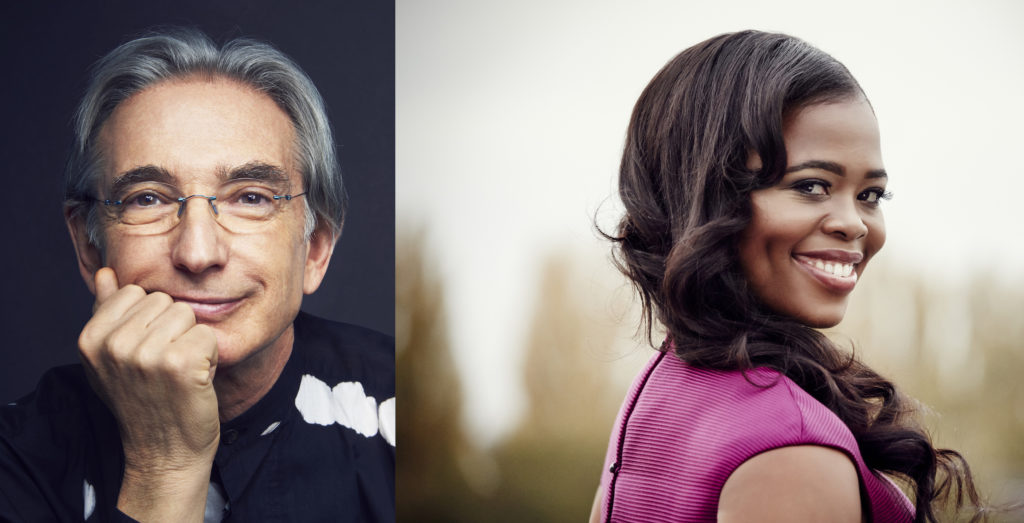When Michael Tilson Thomas walked onto the stage at Carnegie Hall last night, I had a thought: “He has looked the same his entire career” (at least from the seats). “The only thing different is that his hair is white, not dark.” MTT has long been the conductor of the San Francisco Symphony. Last night, he guest-conducted the Metropolitan Opera Orchestra.
Instead of giving the downbeat, he turned around with microphone in hand, to talk. Uh-oh. Every concert is a concert-lecture. This is an inescapable curse. What Tilson Thomas talked about was Carl Ruggles, composer of the first work on the program. Ruggles was an American who lived a long life: from 1876 to 1971. Tilson Thomas met him when he himself was young and Ruggles the opposite. The conductor’s talk last night threatened to exceed the length of the work to be performed.
But I confess, it was interesting.
The work in question was Evocations, consisting of four movements (and lasting twelve minutes altogether). The third movement has the interesting marking “Moderato appassionato.” You will seldom see that, and it might strike you as a contradiction in terms. What are these evocations meant to evoke? That is in the mind of the listener, I think.
These little pieces are somber and intelligent. Listening to them, I thought of three words: concentration, economy, and intensity. Ruggles makes every note count. Other composers have notes to spare, oodles of them. Think of Liszt! The final evocation (Adagio sostenuto) ends on a questioning, unresolved note.
Tilson Thomas and the Met orchestra did well by the Evocations. The unity of the low strings at the beginning was impressive. And when brass entered, they did so unobtrusively. You did not really hear onsets; more like glides. Tilson Thomas clearly understands these pieces, and he clearly communicated that understanding.
After the Ruggles, which uses a very large orchestra, the orchestra shrank considerably for a Mozart piece—one of the most popular, which is saying something: Exultate, jubilate, that sublime motet. The soloist was Pretty Yende, the South African soprano.
In the Mozart, the orchestra’s sound was rather dull. And its accompaniment—if that’s the right word—was workaday, no better. The Met orchestra has spent half its life playing Mozart, with singers! What gave?
A lot fell to Pretty Yende, who did her job commendably. She was clean, accurate, and lovely. Mozart requires low notes in this motet, and hers were very good. As for her high F, it was not especially pretty, but, lo, it was there. Her trills were decent.
In the penultimate section, Tu virginum corona, Yende was notably tender. She sang the music, and the words, like she meant it. And when she sang high and soft, she exhibited admirable control. I could almost feel what she was doing in the diaphragm (my own).
As for the closing Alleluia, it was both peppy and gracious, which was exactly what the doctor—Herr Mozart—ordered.
When it came time for bows, curtsies, and all that, something unusual happened. The soloist seemed to forget the orchestra and the conductor. Tilson Thomas sort of shrugged and had the orchestra stand anyway. Then he himself took kind of a half-bow. It was all very awkward.
This was my impression from the seats, mind you. The musicians themselves might tell you I’m full of it (on more than one front).
There remained one work on the program: Mahler’s Symphony No. 4 in G major, sometimes called his “Mozart symphony.” It is Classical, or Classically inspired. Also, it requires a soprano in the last movement, for which Pretty Yende would duly return.
Michael Tilson Thomas is well known as a Mahlerian, and I have a particular memory of a performance of the Sixth. It was in Washington, long ago, and it was very good. How about the Fourth last night?
The first movement was not a model of precision, even allowing for “live performance.” But the horns? They were excellent here and throughout the symphony. A bonus. This first movement was competent, which ought to go without saying. But it did not impart its magic, at least to me. We are in the realm of intangibles here.
The next movement went better, having its desired puckishness and Gemütlichkeit. The concertmaster, David Chan, contributed fine solo lines: sweet and idiomatic. The third movement is the slow movement, Ruhevoll, meaning restful. It should breathe peace (much of the time). And it did, largely. But the orchestra did not provide a warm sound. And climaxes, which ought to be unbearable, were all too bearable.
Now we get to the last movement, that easeful song. Pretty Yende took a while, getting into her groove. Perhaps it had been the long sit. She entered the stage before the third movement, giving her about a twenty-minute sit. In any case, she found her groove, singing easily. A portamento toward the end was especially effective. Above all, she sang sincerely, and sincerity is the key ingredient in this music (as in a lot of music).
The bowing, etc.? It went off perfectly.
I suppose the end of a review should give a bottom line. This was a competent Mahler 4, an adequate one, not a special one. MTT can do a lot better, and so can the Met orchestra. But look: even a merely competent performance of this symphony is, in a sense, special, because Mahler’s Symphony No. 4 is one of the most beautiful pieces of music ever composed.

